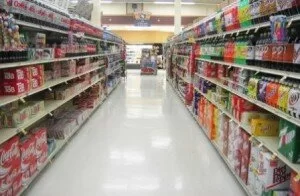
Good shelf location can help your brand grab attention.
The shelf is the new battlefield for brands. As market leaders fight for prime space at eye-level, retailers are using planograms (a fixed layout based on rate of sale and category flows), and smaller brands are under pressure to ensure that they don’t end up on the bottom shelf.
The latest shopper research indicates that shelf location is becoming more and more important as the brands in the different categories increase.
Space at shopper eye-level draws attention.
Shoppers mostly shop in a clockwise direction, starting at eye-level and then moving up towards the upper right, down to the lower right and across to the left.
What does this mean for brands that cannot command a central location on the shelf?
Shopper attention
There are many innovative ways in which smaller brands can command a shopper’s attention.
These include disruptive packaging, a keen and hungry merchandising agency, and in-store media.
Disruptive packaging is the least expensive tactic. This should be part of the packaging design and must be built into the brand. For instance, if all tomato sauces are packed in bottles of a certain shape and colour, there is an opportunity to go against the category norm.
This strategy can be used for sizes, to create perceived better value, or achieve a certain price point.
Using colour as a means to disrupt the category norm is another way to attract attention. Sharp differences in colour allow a pack to stand out on shelf and draw a shopper’s eye.
A word of caution on packaging: The units must be able to fit on the shelf.
Odd sizes tend to end up on the bottom or on the top.
The pack size must utilise the space efficiently. For instance, a full shelf should hold six or 12 units if it is packed in sixes or 12s.
Merchandising
The second important element is a hungry, dedicated third party merchandising team.
However, they are only as good as your instructions as well as how you agree to measure and reward them for their efforts.
This needs to be clearly communicated in a scorecard that is checked and signed monthly. The best of these are where there is a clear “picture” of success. This literally means a graphic illustration of what the shelf must look like. This reduces ambiguity and leaves no room for interpretation at store level.
The final and most costly yet worthwhile mechanics are in-store media. The jury is still out on whether or not these work.
However, they do allow your brand to stand out on the shelf. This can be done through a wobbler, category banner or shelf-talker. All these must clearly communicate the brand message and some sort of benefit to the shopper. These are very expensive activities and should ideally be done in conjunction with a full shopper campaign, and not in isolation.
Cheaper options
There are cheaper ways to get your brand noticed; these include secondary merchandising, where you put your brand in an alternative but complimentary category.
There are also parasite units, for instance, a jam gravity feeder on the bread trolley.
Till points and shelf ends are also opportunities to interrupt shoppers when they are in another aisle or category.
All these strategies and tactics, disruptive packaging, an agency scorecard and in-store media, must hang together within a uniform strategy and must communicate a consistent message.
- Theo Wilscott is the managing director of Ignition Route2Market and has over 15 years’ experience in the fast moving consumer goods (FMCG) sector. Go to www.ir2m.co.za for more information.
